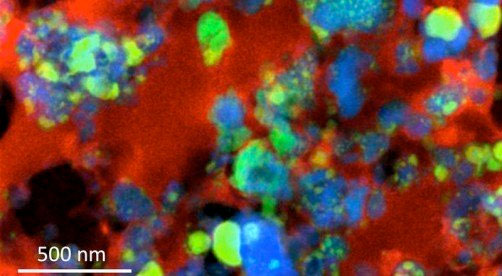| Oct 16, 2019 |
Tracing interstellar dust back to the solar system's formation
|
|
(Nanowerk News) Interplanetary particles from Earth’s upper atmosphere contain dust from the initial formation of the solar system, according to a research team (Proceedings of the National Academy of Sciences USA, "Multiple generations of grain aggregation in different environments preceded solar system body formation").
|
|
The exotic grains may represent the building blocks of planets from 4.6 billion years ago. Analysis of these materials makes it possible to gain deeper insights into the processes that formed and altered our solar system.
|
 |
| Scientists produced this map of tiny glassy grains (blue with green specks) inside a cometary-type interplanetary dust particle using the FEI TitanX microscope at the Molecular Foundry. Carbonaceous material (red) holds these objects together. (Image: Hope Ishii, University of Hawaii and Berkeley Lab)
|
|
This study is the first to confirm dust particles pre-dating the formation of our solar system. Further study of these materials will enable a deeper understanding of the processes that formed and have since altered them.
|
|
A research team led by the University of Hawaii at Manoa studied the chemical composition of particles from Earth’s upper atmosphere using infrared light at the Advanced Light Source, a Department of Energy Office of Science user facility. Scientists also explored their nanoscale chemical makeup using electron microscopes at the Molecular Foundry, another Department of Energy Office of Science user facility, and at the University of Hawaii’s Advanced Electron Microscopy Center.
|
|
The initial solids from which the solar system formed consisted almost entirely of carbon, ices, and disordered (amorphous) silicate, the team concluded. This dust was mostly destroyed and reworked by processes that led to the formation of planets. Surviving samples of pre-solar dust are most likely to be preserved in comets—small, cold bodies that formed in the outer solar nebula.
|
|
In a relatively obscure class of these interplanetary dust particles believed to originate from comets, there are tiny glassy grains called GEMS (glass embedded with metal and sulfides) that are typically only tens to hundreds of nanometers in diameter, or less than a hundredth of the thickness of a human hair. The research team made maps of the element distributions and discovered that these glassy grains are made up of subgrains that aggregated together in a different environment before the formation of the comet.
|
|
The nanoscale GEMS subgrains are bound together by dense organic carbon in clusters comprising the GEMS grains. These GEMS grains were later glued together with other components of the cometary dust by a distinct, lower-density organic carbon matrix. The types of carbon that rim the subgrains and that form the matrix in these particles decompose with even weak heating, suggesting that the GEMS could not have formed in the hot inner solar nebula and instead formed in a cold, radiation-rich environment, such as the outer solar nebula or pre-solar molecular cloud.
|

